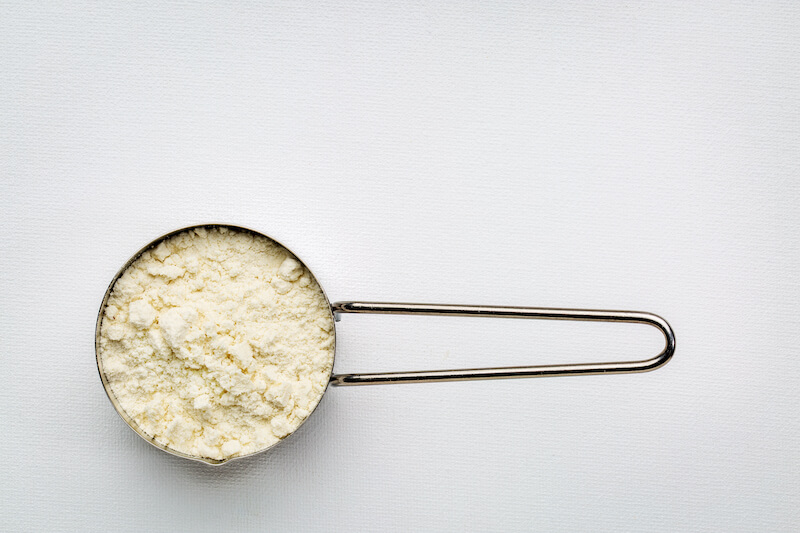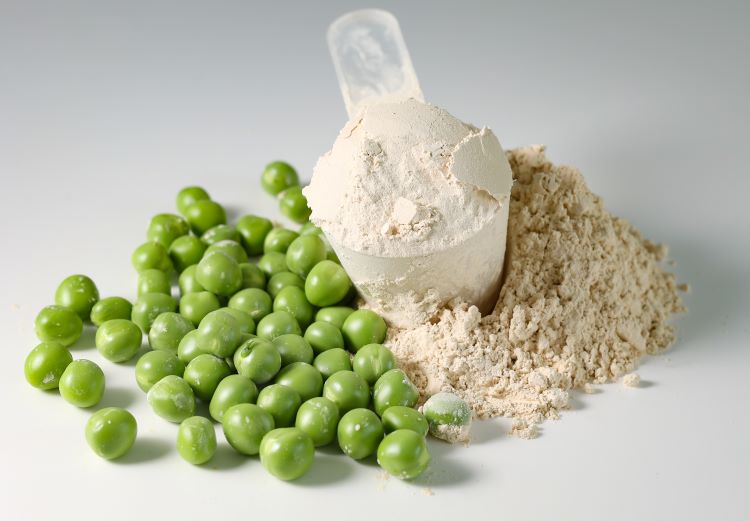Products You May Like
Read on for the ultimate guide on how to use protein powder…
Most of us understand the importance of protein in muscle repair and recovery. And many of us use protein powders as a ideal way to get an immediate post-workout fix to kickstart that process. But knowing what kind of protein to take, how much, and when, can greatly improve how we bounce back from hard training sessions.
Protein forms part of the body’s structure of all cells and tissues. It is essential for the formation, repair and growth of muscle tissue. Proteins are made up of smaller molecules called amino acids. They link together to form complex structures – nine of which are essential and must be obtained from the diet.
Branched chain amino acids (BCAAs) are important, especially leucine. Leucine triggers muscle protein synthesis (MPS), the natural process of producing protein to repair muscle damage caused by intensive exercise. Without leucine, muscle protein synthesis can’t take place.
RELATED CONTENT:

Casein and whey proteins contain all the essential amino acids
What are the main types of protein powder?
Protein powders offer a convenient and measured way to consume protein, ensuring a good balance of amino acids to support MPS after training. There are many types of protein powders, but they can all be categorised into either milk-based or plant-based.
The benefits of milk-based protein powder
Casein and whey are derived from milk. Whey is the most used protein in the sports industry. It’s a by-product of cheese production as the liquid part (whey) separates from the milk.
Casein and whey proteins contain all the essential amino acids, which makes them high quality. While they are both derived from milk, the speed at which they are absorbed in the body influences how they are best consumed.
Whey protein is quickly digested, and amino acids stay elevated in the bloodstream for around 90 minutes after consumption. This type of protein is recommended immediately after exercise to help with MPS.
Whey protein is effective at stimulating growth in humans. This is why whey protein shakes and bars are often taken to improve MPS and the development of lean muscle mass.
Research has shown that whey protein offers benefits when used in tandem with resistance exercise. One study showed that males supplementing with whey protein had more significant relative gains in lean muscle mass.
Whey vs casein protein
There may also be benefits to using whey over casein. According to a study published in the International Journal of Sports Nutrition and Exercise Metabolism, more significant gains in strength and lean body mass were observed amongst men supplementing with whey protein vs casein during a 10-week resistance training program.
Whey protein has also been shown to perform better than soy in augmenting lean body mass.
Want an alternative to traditional protein shakes? These are the best clear protein powders
Whey protein is usually well tolerated, although people with lactose intolerance may need to be more careful as it could trigger symptoms such as stomach cramps, bloating and flatulence.
Casein is broken down more slowly, and amino acids remain elevated for up to five hours in the bloodstream. Studies have shown that pre-sleep casein protein ingestion (timing: 30 minutes before sleep; amount of casein protein ingested: 40-48g) could help post-exercise recovery and positively affect acute protein metabolism and exercise performance. This may be worth considering if you train later in the evening.
The benefits of plant-based protein powders
Plant-based protein powders use soy, pea, hemp, brown rice, potato and seeds. These proteins are combined to achieve a good balance of amino acids, particularly leucine.
Like whey, plant protein powders come as either isolate or concentrate, determining their protein concentration. This varies depending on the source. Soy and pea contain the most significant protein concentration at 90% and 80% respectively. Soy is one of the few plant protein sources with all nine essential amino acids.

Plant-based proteins such as pea protein matches whey protein in terms of muscle development
Plant-based protein powders are suitable for people following a vegan diet or lactose intolerance. Research has shown that plant proteins such as pea produce similar outcomes in body composition measurements, muscle thickness and strength (force production) compared to whey protein.
Plant-based protein powders are more nutrient-dense than dairy-based. They offer antioxidants, vitamins, minerals and essential fatty acids such as omega-3. These proteins are also more easily digested if you struggle with milk.
Want to make meal planning easier? These are the best meal delivery services in the UK
Some plant-protein powders contain less than 25g per serving, but you could take a larger dose or consume it with carbohydrates to help improve protein uptake. They may also lack essential amino acids, so look out for those that contain pea or soy with other plant sources. Soy has always been quite a controversial food, so this may be an issue for some people.
Plant-based protein powders can have a gritty texture that is difficult to mix smoothly. As such, you might not find them as pleasant to drink.
What is whey protein isolate?
Whey protein isolate is similar to concentrate, but it’s undergone extra processing steps to filter out the protein further. This processing reduces the number of carbohydrates (lactose) and fat, resulting in a higher protein concentration.
Whey protein isolate is 90% or more protein, but because of the processing involved may lack other beneficial nutrients found in concentrate. That said, many products are fortified with vitamins and minerals.
Like whey isolates, plant protein isolates are a purified form higher in protein and generally about 90% protein. The most common are soy and pea, but others, such as hemp, are available.
How much protein is needed to build muscle?
Muscle gains in response to resistance exercise are influenced by the training load and the amount, type and timing of protein intake during the following 24-48 hours.
The anabolic muscle response (growth and building) peaks after consuming 20-25g of protein. More than that doesn’t have a significant effect. Which means consuming around 25g of protein post-training and at regular intervals (every few hours) across the day is more beneficial than higher, less frequent doses.
Get your daily protein first thing with the best protein cereals
Current guidance suggests that the intake needed to support metabolic adaptation, repair, remodelling and renewal of protein in athletes ranges from 1.2-2g/kg bodyweight/day. Intakes in the range of 1.4-2g/kg/day are recommended for building muscle mass and strength gains.
To optimise muscle protein synthesis, consume 0.25-0.4g protein/kg bodyweight (minimum 20g) in each meal and distribute your protein intake across the day. Research shows the ‘anabolic window’ extends at least 24 hours after exercising, making what you eat in the day after training just as important as immediately after working out.
How often should you take protein powder?
Food should always come first regarding nutrition. What you eat will inevitably contain more nutrients than just the protein found in a powder. To get the most from your diet, stick to protein powders post-workout and focus on food to get the remaining protein intake across the day.
When to take protein powder?
There is little evidence to suggest that protein powders are any more effective than food at promoting muscle growth and repair after training. However, protein powders offer a more convenient way to consume protein after exercise – especially if you don’t have time to sit down and eat..
Many plant-based protein powders are an excellent option post-workout for those following a vegan diet. The blend of amino acids promotes muscle protein synthesis, as they contain the correct levels of leucine. These powders give you 20-25g of protein in a serving.
The best protein powder is likely to be the one that suits your needs. Most protein powders, whether plant-based or dairy-based, will support muscle protein synthesis after training. The one you choose will depend on personal preference and tolerance.